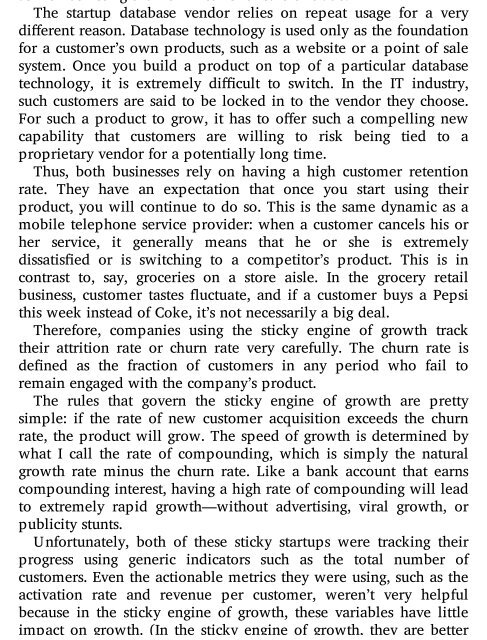Acclaim for THE LEAN STARTUP
The Lean Startup: How Today's Entrepreneurs Use Continuous ...
The Lean Startup: How Today's Entrepreneurs Use Continuous ...
- No tags were found...
Create successful ePaper yourself
Turn your PDF publications into a flip-book with our unique Google optimized e-Paper software.
The startup database vendor relies on repeat usage <strong>for</strong> a very<br />
dierent reason. Database technology is used only as the foundation<br />
<strong>for</strong> a customer’s own products, such as a website or a point of sale<br />
system. Once you build a product on top of a particular database<br />
technology, it is extremely dicult to switch. In the IT industry,<br />
such customers are said to be locked in to the vendor they choose.<br />
For such a product to grow, it has to oer such a compelling new<br />
capability that customers are willing to risk being tied to a<br />
proprietary vendor <strong>for</strong> a potentially long time.<br />
Thus, both businesses rely on having a high customer retention<br />
rate. They have an expectation that once you start using their<br />
product, you will continue to do so. This is the same dynamic as a<br />
mobile telephone service provider: when a customer cancels his or<br />
her service, it generally means that he or she is extremely<br />
dissatised or is switching to a competitor’s product. This is in<br />
contrast to, say, groceries on a store aisle. In the grocery retail<br />
business, customer tastes uctuate, and if a customer buys a Pepsi<br />
this week instead of Coke, it’s not necessarily a big deal.<br />
There<strong>for</strong>e, companies using the sticky engine of growth track<br />
their attrition rate or churn rate very carefully. The churn rate is<br />
dened as the fraction of customers in any period who fail to<br />
remain engaged with the company’s product.<br />
The rules that govern the sticky engine of growth are pretty<br />
simple: if the rate of new customer acquisition exceeds the churn<br />
rate, the product will grow. The speed of growth is determined by<br />
what I call the rate of compounding, which is simply the natural<br />
growth rate minus the churn rate. Like a bank account that earns<br />
compounding interest, having a high rate of compounding will lead<br />
to extremely rapid growth—without advertising, viral growth, or<br />
publicity stunts.<br />
Un<strong>for</strong>tunately, both of these sticky startups were tracking their<br />
progress using generic indicators such as the total number of<br />
customers. Even the actionable metrics they were using, such as the<br />
activation rate and revenue per customer, weren’t very helpful<br />
because in the sticky engine of growth, these variables have little<br />
impact on growth. (In the sticky engine of growth, they are better




